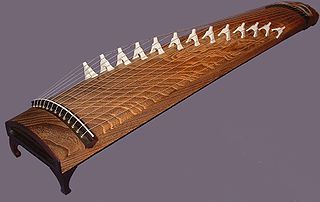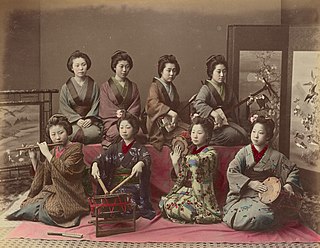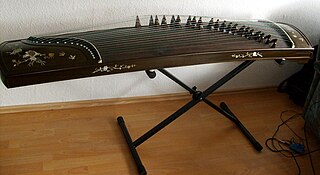
The koto is a Japanese plucked half-tube zither instrument, and the national instrument of Japan. It is derived from the Chinese zheng and se, and similar to the Mongolian yatga, the Korean gayageum and ajaeng, the Vietnamese đàn tranh, the Sundanese kacapi and the Kazakh jetigen. Koto are roughly 180 centimetres (71 in) in length, and made from Paulownia wood. The most common type uses 13 strings strung over movable bridges used for tuning, different pieces possibly requiring different tuning. Seventeen-string koto are also common, and act as bass in ensembles. Koto strings are generally plucked using three fingerpicks, worn on the first three fingers of the right hand.

Zithers are a class of stringed instruments. Historically, it could be any instrument of the psaltery family. In modern terminology, it is more specifically an instrument consisting of many strings stretched across a thin, flat body, the topic of this article.
In music, a bow is a tensioned stick which has hair coated in rosin affixed to it. It is moved across some part of a musical instrument to cause vibration, which the instrument emits as sound. The vast majority of bows are used with string instruments, such as the violin, viola, cello, and bass, although some bows are used with musical saws and other bowed idiophones.

The erhu is a Chinese two-stringed bowed musical instrument, more specifically a spike fiddle, which may also be called a Southern Fiddle, and is sometimes known in the Western world as the Chinese violin or a Chinese two-stringed fiddle.

The geomungo or hyeongeum is a traditional Korean plucked zither with both bridges and frets. Geomungo is a representative stringed instrument made in Goguryeo before the 5th century. Scholars believe that the name refers to Goguryeo and translates to "Goguryeo zither" or that it refers to the colour and translates to "black crane zither".

The guqin is a plucked seven-string Chinese musical instrument. It has been played since ancient times, and has traditionally been favoured by scholars and literati as an instrument of great subtlety and refinement, as highlighted by the quote "a gentleman does not part with his qin or se without good reason," as well as being associated with the ancient Chinese philosopher Confucius. It is sometimes referred to by the Chinese as "the father of Chinese music" or "the instrument of the sages". The guqin is not to be confused with the guzheng, another Chinese long stringed instrument also without frets, but with moveable bridges under each string.
12 Girls Band are an all female Chinese musical group that initially consisted of twelve members before the addition of a thirteenth. Twelve Girls Band use traditional Chinese instruments to play both traditional Chinese and Western music. Formed on June 18, 2001, the women were selected by audition from more than 4,000 contestants. Each woman is classically-trained, and the band members come from various conservatories in the People's Republic of China (PRC), including the China Academy of Music, the Chinese National Orchestra, and the Central Conservatory of Music.

The ajaeng is a Korean string instrument. It is a wide zither with strings of twisted silk. It is played with a slender stick of forsythia wood that is drawn across the strings in the manner of a bow. The ajaeng mainly plays the bass part in ensemble music. And the ajaeng is divided into two types. The ajaeng used in court music is called jeongak ajaeng, and the ajaeng used in folk music is called sanjo ajaeng. The original version of the instrument, and that used in court music, has seven strings; while the ajaeng used for sanjo and sinawi has eight. Some instruments have as many as nine to twelve strings.similar to the koto but bowed

The đàn tranh or đàn thập lục is a plucked zither of Vietnam, based on the Chinese guzheng, from which are also derived the Japanese koto, the Korean gayageum and ajaeng, the Mongolian yatga, the Sundanese kacapi and the Kazakh jetigen. It has a long soundbox with the steel strings, movable bridges and tuning pegs positioned on its top.

Traditional Korean musical instruments comprise a wide range of string, wind, and percussion instruments. Many traditional Korean musical instruments derive from Chinese musical instruments.

The bladder fiddle was a folk instrument used throughout Europe and in the Americas. The instrument was originally a simple large stringed fiddle made with a long stick, one or more thick gut strings, and a pig's-bladder resonator. It was bowed with either a notched stick or a horsehair bow.

Traditional Japanese musical instruments, known as wagakki (和楽器) in Japanese, are musical instruments used in the traditional folk music of Japan. They comprise a range of string, wind, and percussion instruments.
Traditional Vietnamese musical instruments are the musical instruments used in the traditional and classical musics of Vietnam. They comprise a wide range of string, wind, and percussion instruments, used by both the Viet majority as well as the nation's ethnic minorities.

The xiqin was a bowed string musical instrument. It is perhaps the original member of the huqin family of Chinese and Mongolian bowed string instruments; thus, the erhu and morin khuur and all similar fiddle instruments may be said to be derived from the xiqin. The xiqin had two silk strings and was held vertically.

The yatga (Mongolian: ᠶᠠᠲᠤᠭᠠ, romanized: yatug-a, Khalkha dialect: ятга, yatga; pronounced[ˈjɑtʰəq]; is a traditional plucked zither of Mongolia.
The jadagan is a wooden board zither of the Khakas people in Siberia.

The jetigen is a Kazakh and Kyrgyz plucked zither. Similar to Chinese guzheng, yazheng and se, Japanese koto, Korean gayageum and ajaeng, Mongolian yatga, Vietnamese đàn tranh, and Sundanese kacapi. The strings were sometimes made of horsehair. The jetigen is played by plucking, in a similar manner to the gusli, tube zither or box zither.
The paqin is a modern bowed lute originating in China. The instrument has a pear-shaped wooden body like pipa, with neck no frets but bowed by horsehair bow. It has a bass variant, the dapaqin and an alto variant is the xiaopaqin (小琶琴). This is a combination of Chinese pipa with western cello and violin.

The tube zither is a stringed musical instrument in which a tube functions both as an instrument's neck and its soundbox. As the neck, it holds strings taut and allows them to vibrate. As a soundbox, it modifies the sound and transfers it to the open air. The instruments are among the oldest of chordophones, being "a very early stage" in the development of chordophones, and predate some of the oldest chordophones, such as the Chinese Se, zithers built on a tube split in half. Most tube zithers are made of bamboo, played today in Madagascar, India, Southeast Asia and Taiwan. Tube zithers made from other materials have been found in Europe and the United States, made from materials such as cornstalks and cactus.














